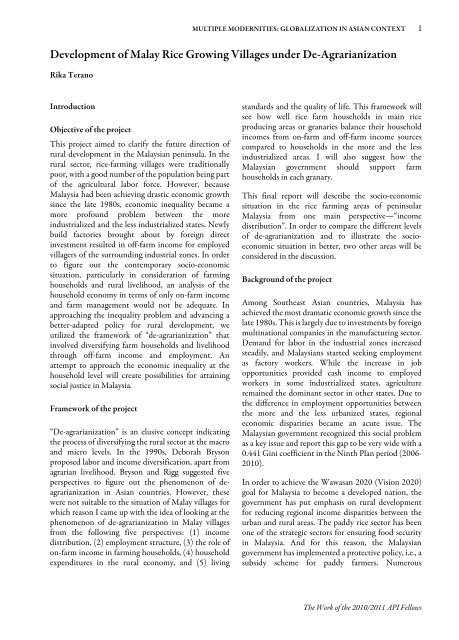Untitled - Api-fellowships.org
Untitled - Api-fellowships.org
Untitled - Api-fellowships.org
You also want an ePaper? Increase the reach of your titles
YUMPU automatically turns print PDFs into web optimized ePapers that Google loves.
MULTIPLE MODERNITIES: GLOBALIZATION IN ASIAN CONTEXT1Development of Malay Rice Growing Villages under De-AgrarianizationRika TeranoIntroductionObjective of the projectThis project aimed to clarify the future direction ofrural development in the Malaysian peninsula. In therural sector, rice-farming villages were traditionallypoor, with a good number of the population being partof the agricultural labor force. However, becauseMalaysia had been achieving drastic economic growthsince the late 1980s, economic inequality became amore profound problem between the moreindustrialized and the less industrialized states. Newlybuild factories brought about by foreign directinvestment resulted in off-farm income for employedvillagers of the surrounding industrial zones. In orderto figure out the contemporary socio-economicsituation, particularly in consideration of farminghouseholds and rural livelihood, an analysis of thehousehold economy in terms of only on-farm incomeand farm management would not be adequate. Inapproaching the inequality problem and advancing abetter-adapted policy for rural development, weutilized the framework of “de-agrarianization” thatinvolved diversifying farm households and livelihoodthrough off-farm income and employment. Anattempt to approach the economic inequality at thehousehold level will create possibilities for attainingsocial justice in Malaysia.Framework of the project“De-agrarianization” is an elusive concept indicatingthe process of diversifying the rural sector at the macroand micro levels. In the 1990s, Deborah Brysonproposed labor and income diversification, apart fromagrarian livelihood. Bryson and Rigg suggested fiveperspectives to figure out the phenomenon of deagrarianizationin Asian countries. However, thesewere not suitable to the situation of Malay villages forwhich reason I came up with the idea of looking at thephenomenon of de-agrarianization in Malay villagesfrom the following five perspectives: (1) incomedistribution, (2) employment structure, (3) the role ofon-farm income in farming households, (4) householdexpenditures in the rural economy, and (5) livingstandards and the quality of life. This framework willsee how well rice farm households in main riceproducing areas or granaries balance their householdincomes from on-farm and off-farm income sourcescompared to households in the more and the lessindustrialized areas. I will also suggest how theMalaysian government should support farmhouseholds in each granary.This final report will describe the socio-economicsituation in the rice farming areas of peninsularMalaysia from one main perspective—“incomedistribution”. In order to compare the different levelsof de-agrarianization and to illustrate the socioeconomicsituation in better, two other areas will beconsidered in the discussion.Background of the projectAmong Southeast Asian countries, Malaysia hasachieved the most dramatic economic growth since thelate 1980s. This is largely due to investments by foreignmultinational companies in the manufacturing sector.Demand for labor in the industrial zones increasedsteadily, and Malaysians started seeking employmentas factory workers. While the increase in jobopportunities provided cash income to employedworkers in some industrialized states, agricultureremained the dominant sector in other states. Due tothe difference in employment opportunities betweenthe more and the less urbanized states, regionaleconomic disparities became an acute issue. TheMalaysian government recognized this social problemas a key issue and report this gap to be very wide with a0.441 Gini coefficient in the Ninth Plan period (2006-2010).In order to achieve the Wawasan 2020 (Vision 2020)goal for Malaysia to become a developed nation, thegovernment has put emphasis on rural developmentfor reducing regional income disparities between theurban and rural areas. The paddy rice sector has beenone of the strategic sectors for ensuring food securityin Malaysia. And for this reason, the Malaysiangovernment has implemented a protective policy, i.e., asubsidy scheme for paddy farmers. NumerousThe Work of the 2010/2011 API Fellows
















